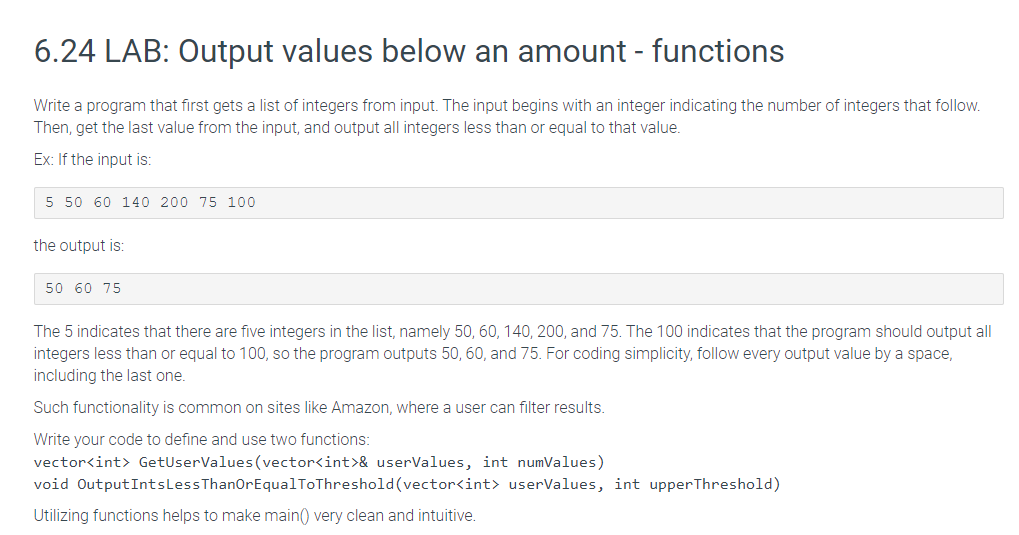include #include using namespace std; /* Define your function here */ int main() { vector userValues; int upperThreshold; int numValues; cin >> numValues; userValues = GetUserValues(userValues, numValues); cin >> upperThreshold; OutputIntsLessThanOrEqualToThreshold(userValues, upperThreshold); return 0; }
include #include using namespace std; /* Define your function here */ int main() { vector userValues; int upperThreshold; int numValues; cin >> numValues; userValues = GetUserValues(userValues, numValues); cin >> upperThreshold; OutputIntsLessThanOrEqualToThreshold(userValues, upperThreshold); return 0; }
C++ Programming: From Problem Analysis to Program Design
8th Edition
ISBN:9781337102087
Author:D. S. Malik
Publisher:D. S. Malik
Chapter6: User-defined Functions
Section: Chapter Questions
Problem 27SA
Related questions
Question
C++
#include <iostream>
#include <
using namespace std;
/* Define your function here */
int main() {
vector<int> userValues;
int upperThreshold;
int numValues;
cin >> numValues;
userValues = GetUserValues(userValues, numValues);
cin >> upperThreshold;
OutputIntsLessThanOrEqualToThreshold(userValues, upperThreshold);
return 0;
}

Transcribed Image Text:6.24 LAB: Output values below an amount - functions
Write a program that first gets a list of integers from input. The input begins with an integer indicating the number of integers that follow.
Then, get the last value from the input, and output all integers less than or equal to that value.
Ex: If the input is:
5 50 60 140 200 75 100
the output is:
50 60 75
The 5 indicates that there are five integers in the list, namely 50, 60, 140, 200, and 75. The 100 indicates that the program should output all
integers less than or equal to 100, so the program outputs 50, 60, and 75. For coding simplicity, follow every output value by a space,
including the last one.
Such functionality is common on sites like Amazon, where a user can filter results.
Write your code to define and use two functions:
vector<int> GetUserValues(vector<int>& userValues, int numValues)
void OutputIntsLessThanOrEqualToThreshold(vector<int> userValues, int upperThreshold)
Utilizing functions helps to make main() very clean and intuitive.
Expert Solution
This question has been solved!
Explore an expertly crafted, step-by-step solution for a thorough understanding of key concepts.
This is a popular solution!
Trending now
This is a popular solution!
Step by step
Solved in 2 steps with 3 images

Knowledge Booster
Learn more about
Need a deep-dive on the concept behind this application? Look no further. Learn more about this topic, computer-science and related others by exploring similar questions and additional content below.Recommended textbooks for you

C++ Programming: From Problem Analysis to Program…
Computer Science
ISBN:
9781337102087
Author:
D. S. Malik
Publisher:
Cengage Learning

C++ Programming: From Problem Analysis to Program…
Computer Science
ISBN:
9781337102087
Author:
D. S. Malik
Publisher:
Cengage Learning